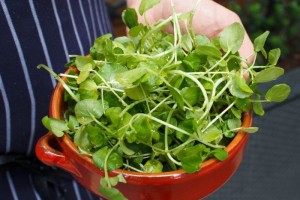ABC Health & Wellbeing: By, Lottie Dalziel

Watercress Close Up
PHOTO: Fresh leafy watercress (Lottie Dalziel)
Kale is often touted as the best of the best when it comes to superfood. But it seems there are more than a dozen other vegetables that pack more nutritional punch than the favourite green of hipsters and health food bloggers.
Chinese cabbage, spinach, parsley and even some types of lettuce are just some of the vegetables that have been found to contain more of certain essential nutrients than kale.
But the veg that you should move to the very top of your next shopping list, is watercress. This delicate and deliciously peppery salad green is the only one to get a perfect nutrient density score of 100. A score assigned by a US research team that identified fruits and vegetables containing 10 per cent or more of the daily recommended intake of critical nutrients, including fibre, iron, protein and vitamins B,C and K. We want to eat foods rich in these nutrients as they have been linked with a reduced risk of developing chronic diseases, including some forms of cancer and cardiovascular disease.
Professor Jennifer Di Noia says powerhouse food rankings aim to “provide clarity on the nutrient quality of the different foods and may aid in the selection of more nutrient-dense items within the powerhouse group”.
Kale only managed to come in at number 15, and it wasn’t the only popular superfood that didn’t make the grade. Berries – well loved by those who claim to be in the know when it comes to nutrition – were also way down the ranking list. This is because researchers were interested in specific nutrients and berries didn’t contain significant amounts of those the researchers were interested in.
So what is it that makes watercress so special? Well, just two cups contain 212 per cent of the daily recommended amount of Vitamin K (a nutrient important for normal blood clotting and protein synthesis in the blood, bones and kidneys). Watercress also contains large amounts of glucosinolate compounds (which inhibit breast, lung, colon and prostate cancer development) as well as smaller amounts of calcium, magnesium and potassium. And did we mention it contains next to no kilojoules?
Shades of green
Don’t despair if watercress isn’t your thing. There are a bunch of other high scoring powerhouse vegetables to choose from, the top 15 include:
watercress
Chinese cabbage
chard
beet greens
spinach
chicory
leaf lettuce
parsley
romaine lettuce
collard green
turnip green
mustard green
endive
chive
kale.
Most of these are green leafy vegetables and they are among the most concentrated source of vitamins and minerals, calorie for calorie. Just adding one cup of leafy greens to your diet every day means you’ll consume up to nine times your daily nutrient intake of Vitamin B, C and K.
As a general rule, you’ll get the most from your powerhouse fruit and vegetables if you consume them raw as essential nutrients can be lost during cooking.
Getting the best from watercress
Some of us are already using watercress in our salads, soups and pastas. But many of us have only read about it in novels, where it features in classic watercress and cucumber sandwiches. It was traditionally consumed as a working class sandwich topping staple in the 19th century.
Watercress is a relatively tolerant plant that loves to get its feet wet. It grows optimally in slow flowing clean water, for example riverbeds and swamps, and is able to survive in temperatures as low as -15 degrees and up to 25.5 degrees Celsius.
Raymond Offler, head chef of Brisbane’s Spring restaurant, uses watercress in many dishes including salads (celeriac and watercress salad), sandwiches (roast beef, horseradish and watercress) and as an accompaniment to a main (slow-cooked lamb belly, artichoke puree, eggplant jam, watercress). He says that it adds “colour and a bit of a spark” to dishes and is less expensive than other herbs.
Like many other dark leafy greens, watercress is a winter vegetable which makes it the ideal ingredient for many soups and pastas. Another way to include watercress in your diet is through salads, and as an extra sandwich topping.
Watercress is best stored in a plastic bag in the fridge with its roots wrapped in a damp cloth.


It is considered as a powerhouse as it could produce numerous nutrients essential
to the body’s normal functioning. When you are thinking
about a diet plan, when it is something you wont be capable of sustain try to find another one.
There are so many strategies and tips available you are certain to get confused.
Great post. I was checking continuously this blog and I’m impressed!
Extremely useful info specifically the last part 🙂 I care for such
information much. I was looking for this certain information for a long time.
Thank you and good luck.
The secret’s having your heartbeat up, instead of having much calories within you,
which means your body decides to burn off of the extra fat.
Drink a good amount of water all day- 6-8 associated with water might help detoxify your whole
body. Be careful with a kind of workout in case you are not physically.
This is my first time visit at here and i am actually impressed to read all at one place.